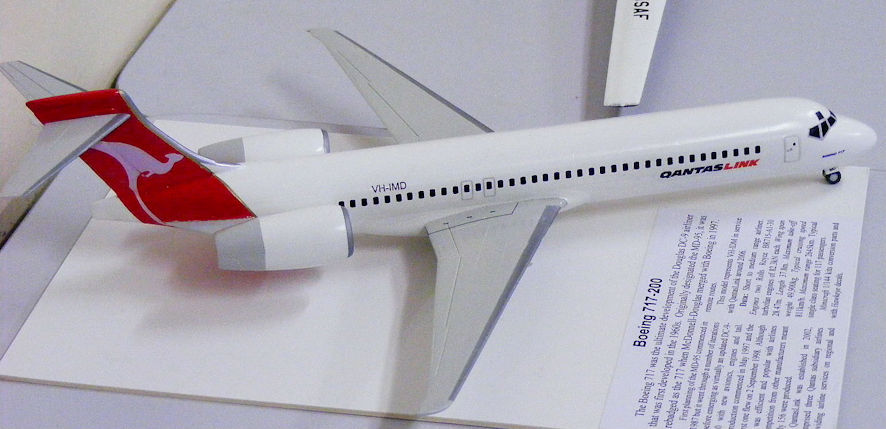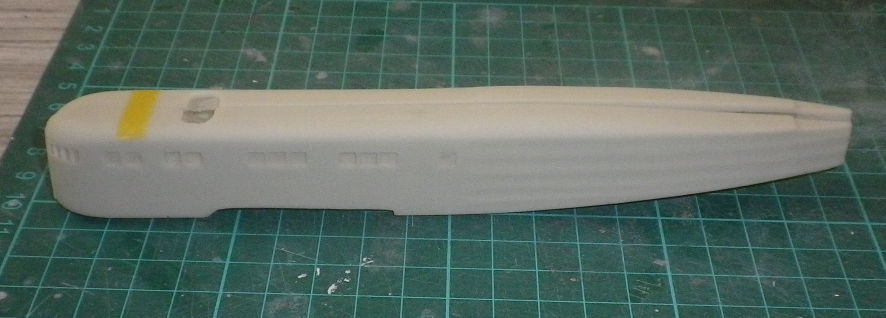(November 2010)
Keen readers will recall that previously I made mention of a couple of projects I was working on. One, the LeO 231 has made no progress since then, perhaps because I’ve found something even more challenging, to use a well worn phrase. But before that, let me finish off the business of the Boeing 717 I also talked about.
Having all the component parts that I thought necessary to make a Boeing 717 out of a Minicraft MD-80 something, I went to the Wikipedia entry on the 717 to use as my guide. This entry is rather long and complicated and follows the history of the development of the MD-95 which became the 717. This history goes back a couple of decades and goes through a number of iterations as the wings were redesigned and fuselage stretched and shortened depending on the thinking about what capacity airliner was most likely to sell well at that time. So I followed this story meticulously, noting when design changes took place and expecting to be able to create an accurate 717 by following all the changes in the design down the years. ‘Ah, so, if the wingspan was x in 1987 then the additional span they settled on in 1989 was now x + y.’ ‘And when they decided to reduce the wingspan in 1992 that means the new wingspan was x + y – z’. And on I went until the design seemed settled, and that was the dimensions I settled on. So I went ahead and made the model based on these calculations. This is why this little segment is called ‘Masochist Corner’.

It might look nice, but it’s merely a product of my fevered imagination
What I didn’t notice was a short paragraph over the page where they said something like, ‘Then they threw out all that planning and settled on an airliner that was basically a DC-9-30 with new engines and tail.’ After all the effort I went to with the intention of making the perfect Boeing 717, what I ended up with was what they planned to build before they decided to go back to basics again. Arrrgh? Fortunately I have a spare DC-9-30 in my Treasure so, one of these days, I’ll cut the tail off the pretend 717 and stick it on the back of the DC-9 to make a real 717. When I can work up the enthusiasm, that is.
All this, however, is but a prelude to true masochism. Those of you at the most recent meeting will have noticed that I was starting on a new kit, from the same maker as the LeO 213, a 1/144 Farman Goliath. I did this because I was headed off to spend the following nine nights in motels in Perth and Canberra to finish off the Tax Office project, and the evenings can get very tedious without something kit-like to play with. I also took along a resin Hawker Siddeley Nimrod and a couple of Viscounts to last the distance. The wings of the Farman are reasonable but the fuselage is problematic (as we say in postmodern discourse). Let me demonstrate with photos:

To show you what a Farman Goliath should look like here is one from a 1/72 kit

Here is the fuselage supplied in the VLE kit

Here is the fuselage after copious applications of plasticard and filler
As you can see, turning the parts supplied in the kit into something approximating a real Goliath is, as they say these days, an ‘issue’.
You may be asking why I do this to myself. It’s not a question I ask myself, often anyhow. Why does Mark indulge in his Kraut Projects, we don’t need to ask that question either. If we did ask the question we would be forced to the conclusion that there is something wrong with us. But we already knew that.
The other projects on the go at the moment include an Anigrand Hawker Siddeley Nimrod and two S & M Viscounts. Some time back I started making these models using Welsh Models vacform kits, but even I have limits. The Anigrand Nimrod is not bad, apart from the squashed engine nacelles, but they’ve recently given employment to the dread Matchbox trench digger so that model is currently smothered in filler.
I started work on the Viscounts during another Tax Office trip earlier in the year that ended up with the completed Bristol Britannia. There are two Viscounts, a 700 series in MMA colours and a 800 series in TAA colours. But vacform kits do not do round engine nacelles very well – did I tell you about how I fixed that with the Britannia – do you really need to know? I doubted that I could get away with that two more times hence the injection molded S & M kits instead. But, oh, those cockpits! Something had to be done about them, involving some drastic surgery to stick the Welsh Model cockpits onto the S & M fuselages.
One pauses to ponder on the mentality of a kit manufacturer with the name that features S and M. Could they be saying something?